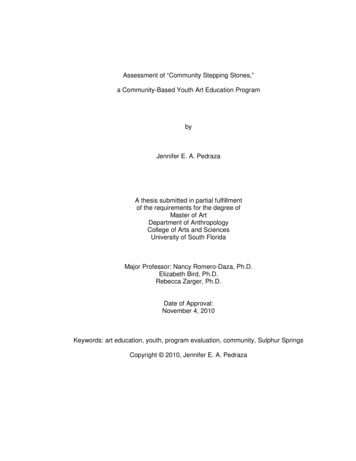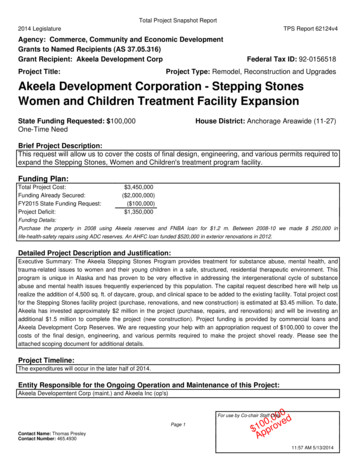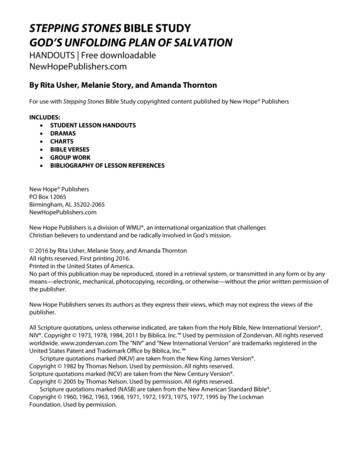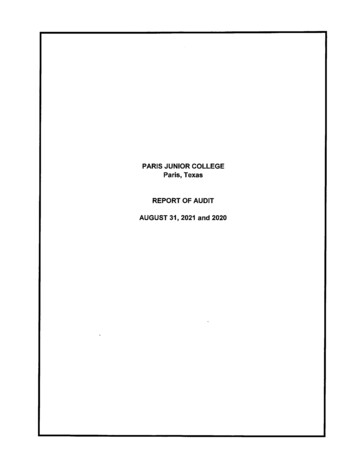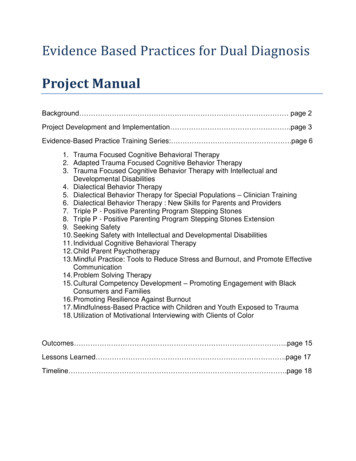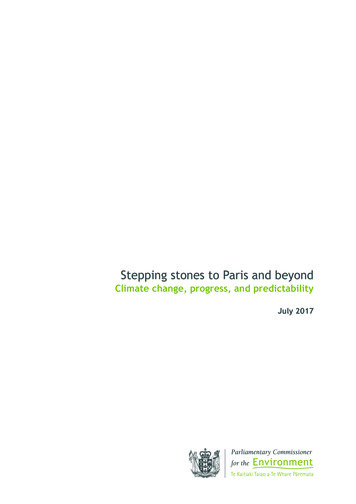
Transcription
Stepping stones to Paris and beyondClimate change, progress, and predictabilityJuly 2017
2Contents1Introduction32How is NZ dealing with climate change?73How is the UK dealing with climate change?114How does NZ compare with the UK?195Could the UK system work in NZ?256Recommendations29Notes35
1Introduction“We need our reason to teach us today that we are not, that we must not try tobe, the lords of all we survey. We are not the lords, we are the Lord’s creatures,the trustees of this planet, charged today with preserving life itself – preserving lifewith all its mystery and all its wonder.”Margaret Thatcher speaking to the United Nations General Assembly in 1989It is fitting that my last report as Commissioner is concerned with what is by far themost serious environmental issue of all – climate change.We live on a planet separated from deep dark space by a layer of gases – a layer ofgases so thin that if the Earth is compared with an apple, the atmosphere would beabout as thick as its skin. In 1895, the Swedish chemist Svante Arrhenius predictedthat burning coal and increasing the carbon dioxide in this thin layer of gaseswould heat the planet. Doubtless influenced by the Swedish weather, he thoughtthat a warming planet was nothing to worry about. Today we know differently.International climate change talks had been ongoing for decades, but theconference in Paris at the end of 2015 was a major turning point. Nearly twohundred countries acknowledged the need to take collective action to reducegreenhouse gases. At Paris, debating about what is fair changed to each countrysaying what it could do.After the Paris conference, the newly appointed Climate Change Minister,Hon Paula Bennett, wasted no time in travelling to New York to sign the ParisAgreement, committing New Zealand to a 2030 greenhouse gas target. Since then,she has tightened some features of the Emissions Trading Scheme, set up workinggroups, and together with the Ministers of Finance and Economic Developmentinitiated an inquiry by the Productivity Commission.The Minister often speaks of the need to bend the greenhouse gas curvedownward, of working to put in place a plan for dealing with climate change, andof providing predictability for business.Many have criticised our 2030 target as being not ambitious enough. For me,the bigger issue is how we chart a pathway to that target and beyond. How dowe change the direction in which we are travelling and make large and lastingreductions in our greenhouse gas emissions?The United Kingdom (UK) began to chart such a pathway in 2008 when it passedthe Climate Change Act with overwhelming cross-party support in the House ofCommons. One of the key features of this Act is that it puts emissions targets inlegislation and sets up a process for reaching them. One of these features is thecreation of stepping stones called carbon budgets.At least nine other countries have passed similar climate change laws, as have anumber of states in the United States, Canada, and Australia.1
Chapter 1 – IntroductionBetween 1990 and 2015, New Zealand’s net emissions have risen by 64%, whilethe UK’s net emissions have fallen by 38%. Not all of this difference is due todifferences in legislation and policies. Nevertheless, the UK’s greenhouse gas curvehas bent downward, whereas ours has not.The question addressed in this report is whether New Zealand should follow the UKand enact a similar climate change law.4My answer is yes, but I would not want such a law to scrape through inParliament. Support across political parties is vital. Climate change is the ultimateintergenerational issue, and governments change.For the private sector, climate change is increasingly seen as a material financial risk.Companies last longer than governments. An apolitical long-term approach built onobjective analysis will provide the measure of predictability that many New Zealandbusinesses are seeking. This would help companies to take up the opportunitiesand manage the risks that will arise in a low-carbon world.In the UK, the creation of carbon budgets provides businesses with adequate leadtimes for making investment decisions. Consequently, climate change policy sitssquarely in economic policy.It is not surprising that support for a climate change law modelled after the UKClimate Change Act is growing, particularly from young people.In 2014, Generation Zero – a youth-led organisation in New Zealand – issued its‘Big Ask‘, calling for a new climate change law that would “hold the Governmentto its promises to reduce carbon emissions”2. In April this year, Generation Zeroproposed an outline for a ‘Zero Carbon Act’ based on the UK model.On Facebook, the Young Nats have now posted:“The Young Nats are proud to support the Zero Carbon Act: Our membershipoverwhelmingly supports the ‘apolitical approach’ to climate change solutionsbeing advocated by Generation Zero. SHARE if you agree that climate changeshouldn’t be a political football.”As Tony Blair said in a speech quoted later in this report, climate change is an issueon which parents should listen to their children.A long-term intergenerational approach is innate to tangata whenua. Kaumātuaoften make decisions based on a “mokopuna’s mokopuna” time scale – thinking ofthe impact on their grandchildren’s grandchildren.3The interest in a UK-style Climate Change Act in New Zealand is not confined toyoung people. This investigation has been prompted in part by the visit earlier thisyear of Lord Deben, Chair of the Committee on Climate Change – an independentcommittee created under the UK law. Lord Deben served in the cabinets ofMargaret Thatcher and John Major, and is certainly not young. But he travelsaround the world arguing persuasively for dealing with climate change in a waythat is largely apolitical and therefore stable over time.Lord Deben is also involved in Globe International – an organisation that bringstogether parliamentarians from more than 50 countries to show leadership onclimate change. A New Zealand chapter has now been established and has alreadycommissioned a report that was presented to the House in April this year.Climate change transcends governments and our approach must do the same. Thisis the focus of what follows.
Chapter 1 – Introduction5Source: Generation ZeroFigure 1.1 Generation Zero launching their Zero Carbon Actoutside Parliament in April. “Climate change is the challenge ofour generation, and young people are the inheritors of humanity’sresponse to climate change.”4Source: Blue GreensFigure 1.2 Lord Deben addressing the BlueGreens Forum in Februarythis year. Lord Deben chairs the UK Committee on Climate Change.
1.1What comes nextThe remainder of this report is structured as follows.6The second chapter is a high level description of climate change policies andlegislation in New Zealand. The focus here, and in the report as a whole, is on thereduction of greenhouse gas emissions (mitigation), rather than adaptation to achanging climate.The third chapter is a description of the different approach that has been takenin the UK as a result of the passage of the Climate Change Act in 2008. Duringthis investigation, staff from my office spent several days in London meeting withpeople from the UK Committee on Climate Change, the Bank of England, a majorinsurance company, key government departments, and others. This was invaluablein understanding how the UK approach to climate change works in practice.The fourth chapter is a comparison of the New Zealand and UK approaches toclimate change. It reveals that the main features of the UK approach are largelyabsent in New Zealand. The very different trajectories of greenhouse gases in thetwo countries are shown, and some of the reasons for the difference are discussed.The fifth chapter transplants the UK approach to climate change into a NewZealand setting. For instance, what kind of institution might be created to provideobjective advice on carbon budgets and review progress towards them?The sixth chapter contains five recommendations, covering how the main aspectsof the UK legislation could be captured in a New Zealand law.Finally, I wish to acknowledge the British High Commission, who assisted in settingup meetings in the UK.
2How is NZ dealing with climate change?In 1993, New Zealand signed up to the first international agreement on climatechange – the ponderously named United Nations Framework Convention onClimate Change (UNFCCC). Under this agreement, signatory countries wererequired to record and report on greenhouse gases, and on actions taken to reducethem.Nine years later, the passage of the Climate Change Response Act enabled NewZealand to ratify the Kyoto Protocol, thus committing to its first internationalgreenhouse gas reduction target.In 2008, the Act was amended to establish an emissions trading scheme – theGovernment’s main policy for making a transition to a low-carbon economy.2.1 TargetsOver recent years, New Zealand has set a succession of greenhouse gas targets.Three have been set following United Nations conferences – a 2012 target at Kyotoin 1997, a 2020 target at Copenhagen in 2009, and a 2030 target at Paris in 2015.A fourth target – the ‘50 by 50’ target – was gazetted by the Government in 2011.These targets are expressed in terms of net emissions relative to gross emissions ina baseline year.Net emissions are gross emissions minus the carbon dioxide taken out of theatmosphere by trees each year.In Table 2.1, ‘net target emissions’ are net emissions that comply with theaccounting guidelines of the relevant target period.Table 2.1 Greenhouse gas reduction targets set by New Zealandgovernments.5TargetTargetyearAs expressedNet target emissions(million tonnes CO2-eqper year)Kyoto2012Net emissions equal to1990 gross emissions66Copenhagen2020Net emissions 5% below1990 gross emissions64Paris2030Net emissions 30% below2005 gross emissions592050Net emissions 50% below1990 gross emissions32New Zealand'50 by 50'Data: NZ Greenhouse Gas Inventory
Chapter 2 – How is NZ dealing with climate change?2.2 Climate policyCurrently, the primary means for reducing greenhouse gases in New Zealand is the EmissionsTrading Scheme (ETS).8Both emissions trading schemes and carbon taxes are known as economic instrumentsbecause they involve putting a price on carbon. (This is shorthand for charging for the rightto emit carbon dioxide.) As the price of carbon rises, reducing emissions becomes moreeconomically attractive.New Zealand’s ETS was originally intended to be ‘all sectors and all gases’. It is the onlyemissions trading scheme in the world that includes forestry. The biological greenhousegases from agriculture – methane and nitrous oxide – have not yet been brought into thescheme.An important difference between New Zealand’s ETS and those in other countries is that nolimit (cap) is put on the number of carbon units.Also, the operation of the New Zealand scheme has allowed unrestricted purchase of carbonunits from other countries.6 Looking ahead, there is no guarantee that New Zealand willcontinue to have access to other carbon markets. Nor is it certain that units that have been‘banked’ will be considered valid for counting towards achieving the Paris target in 2030.Outside the ETS, there are some other initiatives aimed at reducing greenhouse gases.The Ministry for the Environment leads the development of climate policy, but a number ofother government agencies are involved in specific policies and programmes. For instance,the Ministry of Transport encourages the purchase of electric cars through initiatives such asexemption from road user charges.Since the Paris conference, new developments by the Government include: the formation of working groups on forestry, agriculture and adapting to the impacts ofclimate changean inquiry by the Productivity Commission into the opportunities and challenges ofmaking a transition to a low-emissions economyfunding for quantitative analysis of policy options to meet the Paris targetthe release of the 2017–2022 New Zealand Energy Efficiency and Conservation Strategy.7Increasingly the private sector is starting to act. For instance, more than thirty of NewZealand’s largest companies have committed to at least 30% of their corporate car fleetsbeing electric by 2019. Z Energy has built a plant in Auckland that produces biodiesel fromtallow. Westpac is encouraging its customers to invest in clean technology. And DairyNZ andFonterra recently released the first steps of a joint plan to help reduce emissions from dairyfarms.8The Guardians of New Zealand Superannuation have recently announced their intent toreduce the fund’s exposure to fossil fuel reserves and carbon emissions. 9
Chapter 2 – How is NZ dealing with climate change?2.3 How is New Zealand doing?70Million tonnes of CO2-eq per yearKyotoCopenhagen60Paris9504050 by 5030201001990200020102020203020402050Data: NZ Greenhouse Gas InventoryFigure 2.1 New Zealand’s actual net emissions of greenhouse gasesfrom 1990 to 2015 are shown on the green line in this graph. Thepurple line shows the emissions between 2008 and 2015 based onthe Kyoto accounting rules. Under those rules, some of the carbondioxide removed from the atmosphere by trees cannot be countedtowards targets.New Zealand’s net greenhouse gas emissions from 1990 to 2015 (as recorded inthe Greenhouse Gas Inventory) are shown in Figure 2.1. Since 1990, emissions haverisen very significantly, but there has been considerable variation from year to year.Reasons for this include the Global Financial Crisis, lower cattle and sheep numbersduring droughts, tree harvesting cycles, cold winters, and dry years.The four emissions targets that New Zealand has committed to are also shown inFigure 2.1. The graph appears to indicate that New Zealand would meet its Paristarget without reliance on offshore credits if net emissions levelled out. But it is notso simple.First, when targets are set, they are accompanied by rules specifying how emissionsare to be counted. The Kyoto Protocol set 1990 as the base year. Thus, under theKyoto accounting rules, the carbon dioxide removed from the atmosphere by treesplanted before 1990 cannot be counted because nothing additional has been done– the trees were already there. In Figure 2.1, trees planted before 1990 are themajor reason for the difference between the green line and the purple line.Second, in the 1990s, there was a spike in new forest planting. These trees,sometimes referred to as the ‘wall of wood’, will be harvested during the 2020s,and much of the carbon dioxide stored in the wood will begin to return to theatmosphere. This will make the Paris target much harder to achieve.10Finally, there is no direct link between New Zealand climate policy and reaching theParis target. There are no guarantees that the curve will begin to bend or that therewill be access to international carbon credits.
10Source: Parliamentary Commissioner for the Environment archivesFigure 2.2 An electric van making a delivery in Wellington. NewWorld is one of the more than thirty companies committed tomoving part of its fleet to electric. Electric cars hold great potentialfor reducing greenhouse gas emissions in New Zealand. Greenhousegas emissions from road transport have increased by nearly 80%since 1990.11
3How is the UK dealing with climate change?3.1 The genesis of the UK Climate Change ActThe way in which the UK has dealt with climate change is notable for theextraordinarily high level of cross-party support for the Climate Change Act in2008. The Act passed in the House of Commons with 463 ayes and only 3 noes.In large part, this can be attributed to the leadership of two Prime Ministers, onefrom the Conservative Party and one from the Labour Party.In 1989, in a particularly eloquent and heartfelt speech to the United NationsGeneral Assembly, Margaret Thatcher put climate change on the internationalagenda.“The most pressing task which faces us at the international level is to negotiate aframework convention on climate change – a sort of good conduct guide for allnations.” 12In 2004, Tony Blair brought climate change to the top of the international politicalagenda at the G8 Summit in Gleneagles.“We have been warned. On most issues we ask children to listen to their parents.On climate change, it is parents who should listen to their children.” 13Another factor was the release of the Stern review, The Economics of ClimateChange, in 2006. Although aspects of this global benefit-cost analysis havebeen criticised by some economists, the Stern review put climate change into aneconomic frame, showing that there are costs to not acting as well as to acting.When the UK Climate Change Act was passed in 2008, the Conservative Partyspokesperson on Energy and Climate Change commented:“The Bill has attracted an unusual spirit of cross-party co-operation in both Houses the Bill must lay foundations that endure from one Parliament to the other andindeed, eventually, from one generation to another it is this generation that willbe judged on what we did in response to the challenge of climate change.” 14That cross-party cooperation is reflected in the law. The Act has been designed toprovide for sustained action to reduce emissions that does not wax or wane withpolitical will.
Chapter 3 – How is the UK dealing with climate change?12Source: Getty ImagesFigure 3.1 As a chemist Margaret Thatcher readily understood thescience of climate change and the need for urgent action.Source: The Climate Group, flickr (CC BY-NC-SA)Figure 3.2 After he was no longer Prime Minister, Tony Blaircontinued to work on climate change. He is shown here launching areport in Tokyo just before the G8 Summit in 2008.
3.2 Four key features of the UK Climate Change ActThe UK Climate Change Act contains four key features pertinent to the comparisonof UK and New Zealand climate change policy and legislation in this report.13 Emissions targets in legislation Carbon budgets – the stepping stones to targets Policies set by Government to ensure carbon budgets are met An expert body to provide objective analysis and adviceEmissions targets in legislationThe Climate Change Act begins with the UK’s target for 2050 – net greenhouse gasemissions in 2050 must be at least 80% lower than net emissions in 1990.The Act also contains a second target for 2020 – the end of the second Kyotoperiod.15Under sections 2 and 6, the Government can amend either of the targets if thereare significant changes in either scientific knowledge or international law andpolicy.16Carbon budgets as stepping stones to targetsUnder sections 4 to 10 of the Act, UK governments must set out a series of carbonbudgets that lay out a pathway to meeting the 2050 target.A carbon budget is the total net amount of greenhouse gases that can be emittedover a five-year period. Setting budgets for five-year periods allows for someflexibility. Each budget is expressed in terms of millions of tonnes of CO2-eq.The first three budgets had to be set by 2009. These were for the periods 2008 to2012, 2013 to 2017, and 2018 to 2022.Subsequent budgets are to be set at least 12 years in advance. The fourth budgetwas set in 2011, and the fifth budget was set in 2016.
Chapter 3 – How is the UK dealing with climate change?90014Million tonnes of CO2-eq per year800700B1600B2B3500B4400B5300UK 2050 target20010001990200020102020203020402050Data: UK Committee on Climate ChangeFigure 3.3. The first five carbon budgets that have been set in theUK act as stepping stones taking emissions down towards the 2050target.17Policies set by Government to ensure carbon budgets are metThere are no policies in the Act itself. Rather, the Act requires the Government todevelop proposals and policies that will enable emissions to be kept within carbonbudgets.Section 14 requires that a report setting out these proposals and policies be tabledin Parliament.An expert body to provide objective analysis and adviceSection 32 of the Climate Change Act establishes an independent expert body –the Committee on Climate Change. The Committee’s functions are purely advisory– all actions are the prerogative of the Government.The Committee is made up of a Chair and five to eight members. The currentCommittee includes people with expertise in economics, climate science, andtechnology. It is a committee of experts, not a committee of stakeholders. However,care is taken to ensure that, among the Committee members, there is deepunderstanding of buildings, transport, industry, electricity, agriculture, forestry, andso on.18The Committee has two main functions.The first function is to provide advice on carbon budgets – on the level thata budget must be set at, the extent to which the budget should be met bypurchasing international carbon credits, and the extent to which the budget shouldbe met by sectors of the economy within carbon trading schemes.19
The second function is to report annually on progress towards meeting carbonbudgets. These reports are laid before Parliament. While these progress reports doindicate areas where policies need to be developed or strengthened, they do notinclude specific policies. The Government is required to respond to the progressreports within a fixed period.The Committee must also provide advice in response to particular requests. Arecent example of such advice is a report on fracking.20The Committee is supported by a secretariat, currently with a staff of about 30people, largely drawn from government agencies. Much of the work is highlytechnical – for instance, the preparation of scenarios to explore whether carbonbudgets are achievable.21A memorandum of understanding on sharing analysis and research has been set upbetween the Committee and relevant government departments.22 This enables theanalysts in the secretariat to draw on the resources of the wider public sector.Open callfor evidenceOver 200 meetingswith individualstakeholders10 roundtablesand sengagementNewmodellingNewresearchBespoke runsof key governmentmodelsCommitteeexpertise andscrutinyIndependentresearch projectsMonthly CommitteemeetingsSource: UK Committee on Climate Change (adapted)Figure 3.4. The process for gathering and scrutinising evidence usedby the Committee on Climate Change in preparing its advice on thefifth carbon budget.23One member of the Committee on Climate Change, Baroness Brown of Cambridge(Julia King), chairs a subcommittee that gives advice on adaptation to climatechange (see Box 3.1).15
Chapter 3 – How is the UK dealing with climate change?Box 3.1 Adaptation to climate change in the UK Climate Change ActThe Climate Change Act requires the Government to periodically publish a reporton the impact of climate change on the UK. These impact reports are assessmentsof the risks of both the current and the predicted impacts of climate change. Todate, there have been two impact reports – one in 2012 and one in 2017.2416The impact reports are prepared following advice from the AdaptationSubcommittee. The advice that informed the 2017 impact report covered risks ina number of areas including coastal flooding, health, water supply, soil, ecology,food production, and pests and disease.25After an impact report has been tabled in Parliament, the Government mustprepare a programme for adaptation to climate change.26The Adaptation Subcommittee reports every year on how the current adaptationprogramme is being implemented.27The impacts of climate change are not just on the physical environment. In 2014,under a reporting power granted by the Act, the Government directed the Bank ofEngland to report on the risk of climate change to the insurance industry.28Climate change is now increasingly viewed as a material financial risk. In a speechat Lloyds of London, the Governor of the Bank of England, Mark Carney, said:“ climate change will be felt beyond the traditional horizons of most actors –imposing a cost on future generations that the current generation has no directincentive to fix.”29
3.3 How is the UK doing?Figure 3.5 shows the downward trajectory of greenhouse gas emissions in the UKsince 1990.Although greenhouse gas emissions in the UK were falling before the 2008 ClimateChange Act, the setting of carbon budgets demonstrates a serious intent tocontinue this downward path.The first two carbon budgets have been met, and the country is on track tomeeting the third. But as discussed in the next chapter, meeting the fourth budgetwill really test the resolve of the UK.900Million tonnes of CO2 -eq per year800700B1600B2B3500B4400B5300200UK 2050 target10001990200020102020203020402050Data: UK Greenhouse Gas Emissions National Statistics: 1990-2015Figure 3.5. The United Kingdom’s net emissions of greenhouse gasesfrom 1990 to 2015. Five carbon budgets have now been set.17
18
4How does NZ compare with the UK?There are three sections in this chapter.In the first section, the four key features of the UK Climate Change Act arerevisited, with the aim of seeing the extent to which they are reflected in NewZealand law and policy.The second section begins with the great contrast between what has happened toemissions in the UK and what has happened to emissions in New Zealand. The UKhas tracked downward and New Zealand has tracked upward.In the third section, this contrast between what has happened to emissions inthe two countries is explored. Intercountry comparisons are always fraught with‘apples and oranges’, so how fair is the comparison? And is the difference in thegreenhouse gas trajectories due to better law and policy in the UK?4.1 The four key featuresThe first three key features of the UK Climate Change Act – emissions targets inlegislation, setting carbon budgets, and the requirement for policy to be developedthat meets the budgets – provide predictability and reduce the risk of abrupttransitions.Ensuring a smooth transition to a low-carbon economy is not just the responsibilityof the current Government, but also the Governments that succeed them into thefuture, whether they be blue, red, green, or any other colour.The fourth key feature – the independent advisory body – adds expert evidence,and transparency.Emissions targets in legislationNew Zealand has adopted four greenhouse gas targets over the last fifteen years– the 2012 Kyoto target, the 2020 Copenhagen target, the 2030 Paris target, andthe 2050 ‘50 by 50’ target.The now historic Kyoto target was binding through international law, but theothers are not. Nor have any been incorporated into domestic legislation. 30 Incontrast, the UK 2050 target is the subject of the first section of the UK ClimateChange Act.Moreover, the UK 2050 target is expressed in ‘net-net’ terms with a base year of1990 – the net emissions in 2050 are to be 80% below the net emissions in 1990.The New Zealand targets confusingly compare future net emissions with grossemissions in different base years.When expressed in net-net terms, and with 1990 as a consistent base year, NewZealand’s Paris target is 67% above 1990, and the 2050 target is 6% below 1990.Although these targets are not ambitious, given the increase in emissions since1990, achieving them will not be ‘business-as-usual’.
Chapter 4 – How does NZ compare with the UK?Carbon budgets as stepping stones to targetsUnder the UK Climate Change Act, carbon budgets are to be set for five-yearperiods into the future. Each budget must be set well before it comes into effect.20A major reason for setting carbon budgets is to avoid the need for abrupttransitions. This is why assessing and modelling technology trends is vital.In contrast to the UK, New Zealand has not yet set any carbon budgets, or anyother kind of plan for reaching the targets. Setting some kind of declining cap oncarbon credits in the ETS could be one approach, although the ETS is currently acap-and-trade system without a cap.31Policies set by Government to ensure carbon budgets are metThe UK Climate Change Act requires the Government to prepare carbon plans thatlay out the policies and programmes expected to keep emissions within carbonbudgets and on track to the 2050 target. If the country is not on track for meetingcarbon budgets, then the Government must say why not and what they are goingto do about it.The carbon budgets are explicit about what is to be achieved domestically andwhat can be achieved by buying offshore carbon credits. They are also explicitabout what the European Union ETS can be expected to deliver, thus showing howmuch must be dealt with through other mechanisms such as regulation. Both thesedimensions of carbon budgets help to ‘tie down’ the carbon plans.In New Zealand, the development of climate policy is distributed across differentgovernment agencies, and can be crowded out by other priorities.Further, it is not shown how policies contribute to meeting targets. For instance,one of the priorities in the New Zealand Energy Efficiency and ConservationStrategy is that electric vehicles are to form 2% of the fleet by 2021. But how farwill this go towards helping us achieve our Paris target?Overall, there is no systematic quantification of reductions in greenhouse gasesfrom climate change initiatives in New Zealand. A United Nations expert review hascriticised New Zealand for this omission.32 The new funding for “costed, tested andconsulted policy options for reducing emissions domestically” in the 2017 Budgetshould go some way to remedying this.Expert body to provide objective analysis and adviceNew Zealand does not have an independent advisory body of experts on climatechange that is analogous to the UK Committee on Climate Change.The Parliamentary Commissioner for the Environment can produce reports likethis one, but is not a body of experts, and cannot focus only on climate change.Although the Productivity Commission is currently preparing a report on climatech
the impact on their grandchildren's grandchildren.3 The interest in a UK-style Climate Change Act in New Zealand is not confined to young people. This investigation has been prompted in part by the visit earlier this year of Lord Deben, Chair of the Committee on Climate Change - an independent committee created under the UK law.
